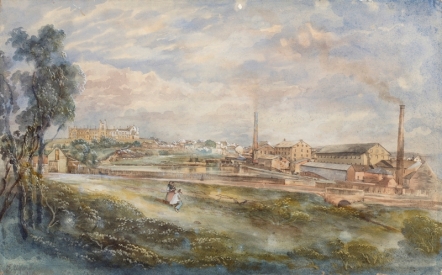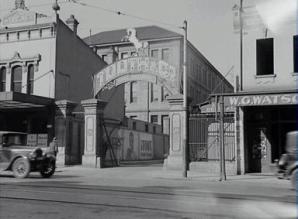This weekend is the inaugural Beams Chippendale Arts festival. The festival is aiming to showcase the creative talent that has flocked into the area over the past 10 years or so as well as dipping its lid to the areas history.
Chippendale is a little suburb with a big history. Jammed in between Regent Street, City Road, Cleveland Street and Broadway, Chippo is being gentrified quicker than maybe any other Sydney locality. It all started for Europeans as a well-watered farm and grazing land, used by the military for their food gardens from the earliest years of the 1800s and then granted to William Chippendale in 1815. However it soon began to industrialise.

The area was well suited to nineteenth century industry. Blackwattle Creek ran through the land heading towards the harbour and in 1825 the Brisbane Distillery of ex-convict Robert Cooper was the first to take advantage of it.
Cooper’s distillery fronted Parramatta Road, extending from what is now St Benedict’s Church to the City Road corner. It developed quickly into a major enterprise, costing over £20,000 (today being equal to $3 million or so) and including 2 steam engines (cutting edge for the day), malting houses, warehouses and a flour mill. Cooper built a dam across the Creek to supply the water for the operation, which later became a popular fishing spot for locals.
As well as being a distiller, Cooper was a crafty businessman. Many times during his life he twisted and turned to avoid creditors and ruin. From the 1830s he began using the distillery as collateral to fund other ventures. By 1843 he was heavily in debt and used the distillery to finance house construction in Chippendale, to house working class families and to encourage them to vote for him in the first Legislative Council elections (he lost badly). The houses were later some of the worst slums in the area-small, poorly built and badly sited. His venture nearly sank him and he went into voluntary bankruptcy to avoid his creditors.
In 1850 Cooper’s estate was taken over by a solicitor to pay his debts. Cooper however managed to regain control by using hidden funds to buy it back. But the end was nigh, and in 1852, Cooper and his partners, sold the distillery complex to the Australasian Sugar Company, later to be renamed the Colonial Sugar Refinery (CSR) for use as their main Sydney sugar refinery.

Across Abercrombie Street from Cooper was another alcohol related industry, the Kent Brewery. Unlike Cooper, John Tooth who started the brewery, and his family who continued it, were level headed and astute businessmen. As a result the brewery operated and expanded on the site from its establishment in 1834 until final closure in 2005.
When Tooth’s opened there were ten breweries in Sydney. In 1843 there were three; seven not surviving the first economic crash in the Australian economy. Tooth’s business acumen and quality product (for the time) ensured they were one of them.
Disaster struck in January 1853 when fire destroyed a large portion of the site. Rather than being the death knell, the fire allowed for a modernisation in the plant and the beginnings of its expansion. The first expansion came after the fire when the brewery site extended to front Parramatta Road (Broadway).
By 1901 the brewery was extended west to take in the adjacent streets, and by 1915 it had gone further west to approach Abercrombie Street. Although shops and some residences still fronted Parramatta Road the brewery owned them and they were demolished as the site expanded. By 1975 the brewery fronted Parramatta Road west of Kensingon St all the way to Abercrombie Street and then south along Abercrombie. Hotels, built and owned by the brewery marked the four corners of their property. The hotels were the perfect outlet for the product-the most famous being KB the abbreviation of Kent Brewery.
The brewery closed in 2005 and is now being redeveloped as Central Park, the largest of the post-industrial redevelopments in the area.
September 24, 2012 at 3:47 pm
There was an old hotel at the southern end of the brewery site. It was operating from the late 1800’s to the early 1900’s in Abercrombie Street and it was called the Q.C.E. Hotel. Does anyone know what the letters Q.C.E. stood for?
May 12, 2014 at 5:12 pm
My great aunt used to run the QCE Hotel. She said it stood for Quality, Civility and Excellence.
May 15, 2014 at 1:35 pm
Nice one Peter. How long did your aunty run the pub for?
September 25, 2012 at 9:51 pm
When Tooths opened, there were ten professional breweries in Sydney. Since the population was still small back then, Sydney men must have drank themselves blotto every night of the week, or the Sydney breweries exported beer to other colonies and to the Motherland.
Is the post-industrial redevelopment razing the brewery buildings to the ground and building from scratch? Or are the architects preserving and adapting the existing architecture?
October 12, 2012 at 2:28 pm
Yes, Sydney has always had a thirst for beer, although the majority of the nineteenth century breweries were on a much smaller scale then Tooths was in its later life.
the redevelopment has retained some of the buildings in the design, most notably the central brewing buildings and the large main chimney. Some of the machinery is also being retained and incorporated into interpretation and community art. So not all is lost.
October 12, 2012 at 4:51 pm
Thank you. I would love to see the redevelopment, after it is completed.